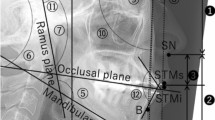Abstract
Objective
The aim of this study was to evaluate the relationship between surgical zygomatic arch fracture reduction and mandibular movements in different fracture types.
Materials and Methods
Fractures were classified according to the Yamamoto classification. The extent of zygomatic arch reduction after surgery was evaluated by measuring three reference points on both fractured and normal side both before and after surgery. The selected reference points were: the most anterior (A1), the most posterior (B1) and the midpoint (C1) relative to midsagittal plane on the fracture side and the same points on the normal side (a1, b1, c1). Mouth opening, movements to right and left were recorded in these patients.
Results
The highest extent of zygomatic arch reduction was observed at the midpoint of the arch (p = 0.041). Surgery did not significantly alter other points of the zygomatic arch. The extent of reduction of the zygomatic arch was not significantly associated with mandibular movements. However, type of fracture correlated with lateral excursion to the right and left (p = 0.002 and p = 0.031, respectively).
Conclusion
This study showed that the amount of post-surgical changes in zygomatic arch reduction was not significantly related to mandibular movements. In addition, the amount of lateral excursion two weeks after surgical correction of more severe types of zygomatic arch fractures was less compared with other fracture types. Patients with more severe fractures may need to be followed for a longer period of time in order to regain the normal mandibular movement range.



Similar content being viewed by others
References
Kim JS, Park YJ, Lee YJ, Kim NG, Lee KS (2016) Reduction of zygomatic arch isolated fracture using ultra sound and needle marking. Arch Craniofac Surg 17:198–201
Yamamoto K, Murakami K, Sugiura T, Fujimoto M, Inoue M, Kawakami M et al (2007) Clinical analysis of isolated zygomatic arch fractures. J Oral Maxillofac Surg 65:457–461
Gomes PP, Passeri LA, de Albergaria Barbosa JR (2006) A 5-year retrospective study of zygomatico-orbital complex and zygomatic arch fractures in Sao Paulo State. Brazil J Oral Maxillofac Surg 64:63–67
Brucoli M, Boffano P, Broccardo E, Benech A, Corre P, Bertin H et al (2019) The “European zygomatic fracture” research project: the epidemiological results from a multicenter European collaboration. J Craniomaxillofac Surg 47:616–621
Hönig JF, Merten HA (2004) Classification system and treatment of zygomatic arch fractures in the clinical setting. J Craniofac Surg 15:986–989
Özyazgan I, Günay GK, Eskitaşçıoǧlu T, Özköse M, Çoruh A (2007) A new proposal of classification of zygomatic arch fractures. J Oral Maxillofac Surg 65(3):462–469
Błaszczyk B, Studziński M, Ładziński P (2019) Coincidence of craniocerebral and craniofacial injuries. J Craniomaxillofac Surg 47:287–292
Giudice A, Cristofaro MG, De Cicco D, Barca I, Orabona GDA, Califano L (2020) Percutaneous reduction of isolated zygomatic arch fractures: a 5-year experience. J Oral Maxillofac Surg 78:973–978
Bao T, Yu D, Luo Q, Wang H, Liu J, Zhu H (2019) Quantitative assessment of symmetry recovery in navigation-assisted surgical reduction of zygomaticomaxillary complex fractures. J Craniomaxillofac Surg 47:311–319
Patini R, Gallenzi P, Meuli S, Paoloni V, Cordaro M (2018) Clear aligners’ effects on aesthetics: evaluation of facial wrinkles. J Clin Exp Dent 10:e696
Toriumi M, Nagasao T, Itamiya T, Shimizu Y, Yasudo H, Sakamoto Y et al (2014) 3-D analysis of dislocation in zygoma fractures. J Craniomaxillofac Surg 42:397–402
Li Z, Yang R-T, Li Z-B (2015) Applications of computer-assisted navigation for the minimally invasive reduction of isolated zygomatic arch fractures. J Oral Maxillofac Surg 73:1778–1789
Cavalcante JR, Junior JRC, Peixoto TS, de Albuquerque TTP, Cavalcanti AL (2015) Reduction and fixation of unstable fractures of the zygomatic arch: report of a series of cases. J Surg Tech Case Rep 7:29–31
Gillies H, Kilner TP, Stone D (1927) Fractures of the malar-zygomatic compound: with a description of a new X-ray position. Br J Surg 14:651–656
Gruss JS, Van LW, Phillips JH, Antonyshyn O (1990) The importance of the zygomatic arch in complex midfacial fracture repair and correction of posttraumatic orbitozygomatic deformities. Plast Reconstr Surg 85:878–890
Gadkari N, Bawane S, Chopra R, Bhate K, Kulkarni D (2019) Comparative evaluation of 2-point vs 3-point fixation in the treatment of zygomaticomaxillary complex fractures—a systematic review. J Craniomaxillofac Surg 47:1542–1550
Furst IM, Austin P, Pharoah M, Mahoney J (2001) The use of computed tomography to define zygomatic complex position. J Oral Maxillofac Surg 59:647–654
Chu SG, Lee JS, Lee JW, Yang JD, Chung HY, Cho BC et al (2019) Comparisons among four types of absorbable plates used for internal fixation of zygomaticomaxillary complex fractures. J Craniomaxillofac Surg 47:383–388
Acknowledgements
We kindly express our gratitude to Dr. Narges Pouremadi.
Funding
This study was financially supported by Shiraz University of Medical Sciences as a partial requirement for obtaining DDS degree (#12309).
Author information
Authors and Affiliations
Contributions
Design and concept: MSK, MB, AH; data collection: MB, ME; data analysis and interpretation: PS, RP; preparing the original draft: MB, ME, AH; revision of the draft: MSK, PS, RP.
Corresponding author
Ethics declarations
Conflict of interest
None.
Ethical Approval
This study was approved by the Ethics Committee of Shiraz University of Medical Sciences (#IR.SUMS.REC.1395.S1095).
Additional information
Publisher's Note
Springer Nature remains neutral with regard to jurisdictional claims in published maps and institutional affiliations.
Rights and permissions
Springer Nature or its licensor (e.g. a society or other partner) holds exclusive rights to this article under a publishing agreement with the author(s) or other rightsholder(s); author self-archiving of the accepted manuscript version of this article is solely governed by the terms of such publishing agreement and applicable law.
About this article
Cite this article
Khaghaninejad, M.S., Bahreini, M., Soltani, P. et al. Evaluation of the Relationship Between Zygomatic Arch Fracture Reduction and Mandibular Movements. J. Maxillofac. Oral Surg. (2024). https://doi.org/10.1007/s12663-023-02088-y
Received:
Accepted:
Published:
DOI: https://doi.org/10.1007/s12663-023-02088-y




